 |
|
 |
�@The area between Ryogoku-bashi Bridge and Eitai-bashi Bridges used to be seashore during the Edo Era. This area is called �gHamacho, Nihonbashi�h, which literally means �gSeashore town�h. Hamacho is also known for its upper class Japanese restaurants that serve a traditional style of the Japanese cuisines. Today, the traditional atmosphere still remains in the Hamacho area, for instance, the Meiji-za Theater and Hamacho Park. This month, we interviewed Maestro. His real name is Munechika Inazaki. He is the 5th owner of the �gKyoshindo Inazaki�h who mounts hanging scrolls, folding screens, and such items from the Hamacho area. |
 |
 |
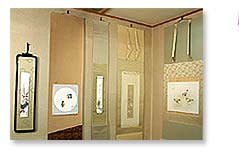
|
| �gDaikyoji�h,the Mounter called Hyougushi in Japanese |
 |
 |
|
�@Kyoshindo Inazaki was founded in Nihonbashi during Tenpo (1830-1843) in the Edo Era. It used to be in the carpenter district, Nihonbashi 2 choume, close to the Edo Castle. One store has been given exclusive permission to use the title, �gDaikyoji�h and is the only store to control the entire framing market. Unfortunately, the original store was burned down during an air raid on Tokyo.However, it was later rebuilt, moved to Hamacho Nihonbashi and renamed. Today, Munechika Inazaki runs the business with his two sons Tomonobu and Masahito. Their business is �eframing�f, a traditional craftwork consisting of mounting scrolls, folding screens, picture frames, and so forth. Making a hanging scroll, for example, requires a comprehensive understanding of artistic sensitivity and framing skill. Frames are crafted by joining pieces of silk cloths, called �gKireji,�h together with the end product evoking a type of painting or calligraphy. Kyoshindo Inazaki, produce and sell not only the traditional frames works, but also modern products such as trendy current interior designs.
|
|
|
 |
| Serving the area for 5 generations |
 |
�@Munechika Inazaki was born in 1937 in Nihonbashi. In the 6th grade he started helping his father build frames.Soon after graduating from high school at the age of 18 he worked hard to learn about the �eframing�f business.Today, like his father, he is a skilled craftsman. His father being the frame-mounter, made it a natural progression for him to continue the family business. It did, however, take him several years to learn each of the intricate framing techniques. He naturally inherited many of his family�fs tastes and skill styles which can be seen in his work.The ethos that states, family and environment have the greatest affects craftsman�fs designs, is true. He admits, his work was also inspired by the Nihonbashi area. What�fs more, he believes that it is important to challenge old styles with new ideas while never losing sight of those traditions passed on from generation to generation.
|
|
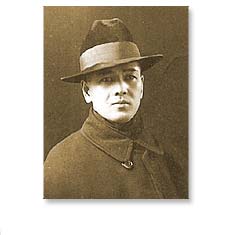 |
 |
 |
 |
 |
 |
 |
| |
|
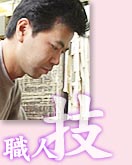
The Crafting Process
�@The process of making Hyougu takes anywhere from one months or longer. In some cases it could take over one year to complete a single hanging scroll. Shoji the second son explains in detail how each Hyougu takes to craft. First, the paintings or calligraphy are selected and drafted carefully. Next, the style of Kakejikuis is chosen. Then, the �gkireji�h, is artistically coordinated with the three different parts of cloths, �gIchimonji�h, �gNakafuchi�h and �gTenchi�h. After that each cloth is cut and moistened with a �eHake�f style brush in order to prevent expansion or possible shrinking due to humidity. Next, the end of each attached cloth is held. These are called �gJiku,�h �gHasso,�h and �gFutai�h. The Jiku is then nailed and finally completed by attaching the scroll onto a string. The most important part of framing work is what is finally portrayed. The picture and scroll have a type of superior-subordinate relationship.For this reason, great effort is taken to ensure that each scroll is displayed under the best conditions possible.
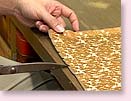 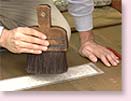 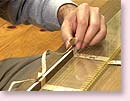
| 1.Mizuhiki |
|
2.Moistens cloth with brush |
|
3.Attaching scroll onto string |
|
|
|
|
 |
 |
 |
 |
 |
 |
|
 |

|
| Our Philosophy & Aim |
 |
 |
|
�@The highest possible complement is for a customer to say, �gI always display the scrolls that were craft by you.�h Too keep the compliments coming, we are committed to honesty, working hard and priding our work. One satisfied customers wrote us a letter regarding �gYokei,�h mentioning that, we should find happiness by making customers happy with the high quality of products they receive; this has become our aim.We strongly believe that it is important to build a reputation through hard work, integrity and earnestness. We have always been and still are committed to creating scrolls which fit modern homes and apartments with or without tatami mat rooms.
|
|
|
 |
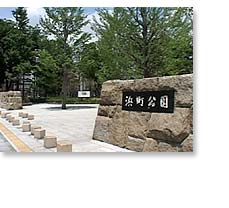
|
| Nihonbashi Hamacho |
 |
 |
|
�@
Hamacho, Nihonbashi used to be a stylish town with traditional upper class restaurants and Hogunate houses. A generation earlier, one could hear the sound of Nagauta singings, Shamisen music, and Japanese clogs worn by Junior Geisha. Those styles have survived and can still be seen by people of this area today. It is our hope that these historical traditions continue to be remembered and practiced by contributing to regional development through our work.
|
|
|
|
 |
 |
 |
 |
| |
 |
|
 |
Kyoshindo Inazaki
-A variety of hanging scrolls on colored paper 3,000 yen
-Edo Silk scrolls (43,000 yen)
-Shiko Munakata Woodblock paintings (12,000 yen)
-Fifty-three stages of the Tokaido Pints (15,000 yen) are also available.
You can find which craft best fits you apartment or house.
Kimono or Sash remakes are available, personalized crafts are also available on request.
|
 |
 2-48-7 Hamacho, Nihombashi, Chuo-ku 2-48-7 Hamacho, Nihombashi, Chuo-ku
Ph:03-3666-6494
FAX:03-3666-6989
URL:http://www.kyoushindo.com
E-mail:info@kyoushindo.com
Office Hours 9:00�`18:00 |
|
|
 |
 |
 |
|
 |
|
 |